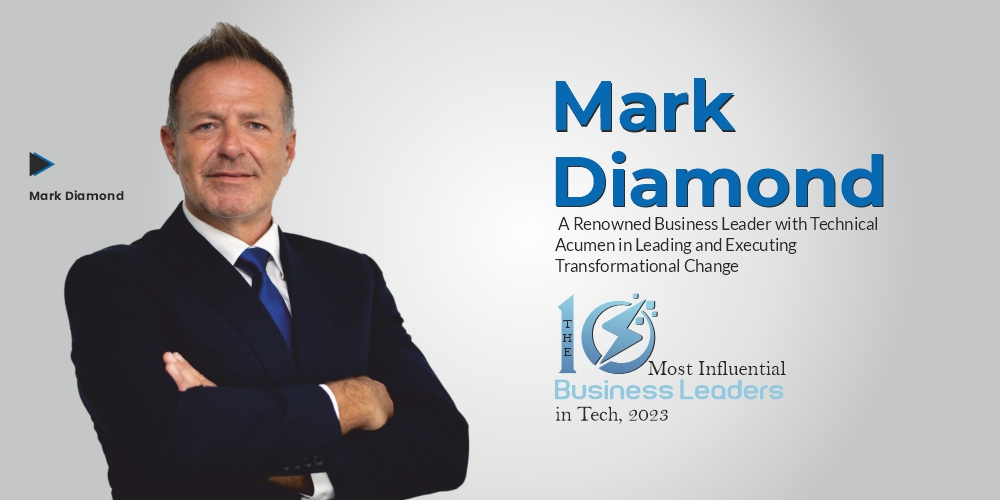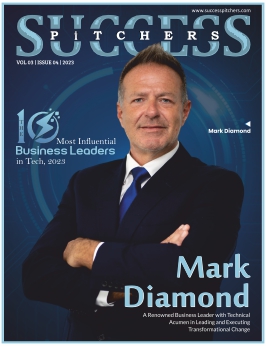Mark Diamond - A Renowned Business Leader with Technical Acumen in Leading and Executing Transformational Change
The 10 Most Influential Business Leaders in Tech, 2023

Mark Diamond is a highly accomplished executive leader and board member. Known for his exceptional business and technical expertise in international and Islamic banking, finance, and payment technologies, Mark excels in driving transformational change. With a professional doctorate in information technology, training from top business schools such as Harvard, Columbia, and the London Business School and core competencies in the field of Electronic Engineering, Mark brings a unique blend of entrepreneurial and situational leadership to his work.
Mark has a proven track record of achieving both strategic and operational success in the face of intense change and competitive pressures. Having held senior leaderships roles in Europe including Royal Bank of Scotland and Deutsche Bank through to Al Rajhi Bank and Network International in the Middle East, where did this journey all begin?
Skateboarding – the key to future success
Mark was born in Glasgow, Scotland, the oldest of three siblings with two younger sisters. He was raised in an environment that emphasized kindness, friendliness and laughter, which are commonplace amongst most Glaswegians. This upbringing had a significant impact on shaping Mark’s character and personality. He shares, “My father is what I would describe as academic. A chartered accountant by day but in the evenings and weekends, he loved nothing more than going to the theater, the cinema, and watching football, and he had a wicked sense of humor.” His upbringing was typical of the era, with his mother serving as a traditional homemaker and his father working outside the home. This background shaped Mark’s character and instilled in him the principle of putting family first.
As a young boy, Mark was enamored with American culture and had a passion for skateboarding. For his 10th birthday, his father gifted him a Santa Cruz skateboard from California, which was the epitome of cool in the late 70s. It’s worth noting that at this time, the internet had not yet been invented and Amazon was just a South American rainforest. He asserts, “The world was a much bigger place back then, and it has always been a mystery to me as to how my father managed to acquire such an exotic item from the other side of the globe.”
One day, Mark fell off the skateboard and crashed it into a wall. The ‘truck’ where the wheels were attached under the board was broken in half – he was distraught. Mark recalls, “My close friend Paul said his dad could fix it as he was an engineer. Engineer eh, Impossible I thought but I was prepared to try anything. Sure enough, some weeks later, Paul’s dad returned the skateboard with the truck fully repaired and you couldn’t even see it had been damaged. Mark was amazed; how was this possible? What magic was this?
It was at this pivotal moment that Mark knew what he wanted to be – an Engineer and he did so through a 5 year Apprenticeship and Education program with Philips Business Systems in Glasgow and then progressed to Compaq Computers for a number of years based in Houston in Texas.
Digital transformation – why planning is critical.
To remain competitive and relevant after the pandemic, mid-sized companies realized they must embrace digital transformation. It became all too clear to most that their future success depended on their ability to transition to a digital-first approach but it’s important not to rush into action – proper planning is needed ! The crucial moment in this transformation journey is the beginning, when decisions are more flexible. This is the best time to make meaningful changes,. Mark believes that without a well-thought-out plan, businesses run the risk of facing misaligned objectives, confused products, and unfavorable outcomes further down the line. It’s essential to take the time to develop a strategic plan to ensure the transformation is a success. He suggests, “Give yourself a month or two. You need to think, ideate, collaborate, and create a roadmap of where you want to go. Take the time to understand what’s needed and what are the essential ingredients to set yourself up for “transformative’ success.”
By failing to prepare, you are preparing to fail.” ― Benjamin Franklin.
Mark believes that even for companies that are already digitally advanced, there is always opportunities and room for improvement. He stresses the importance of continuously evaluating the market for opportunities, fostering innovation, and having the vision and courage to keep looking ahead area areas where you can focus to increase revenue.
He suggests that using data analytics to gain deeper insights and implementing robotics (RPA) to automate manual tasks, improve employee efficiency and thus optimize costs, are a few ways to shift priorities to drive productivity and cost optimization.
Workplace transformation and Culture Shifts – it’s the little things!
Mark believes anything related to ‘culture’ is always going to be challenging. Culture does not change overnight, it must first be understood, then cultivated and allowed to evolve, which all requires time and dedication, particularly in the little things. And it’s the little things that make all difference!
A recent article in Forbes discussed the concept of “micro-moments” and how small groups within an organization can be empowered to drive cultural change in the workplace.
Much like the butterfly effect, where even small changes can have a significant impact, Mark thinks this is a crucial aspect of successfully shifting corporate culture – through “micro-moment” experiences.
Mark points out that large and ambitious cultural change efforts often become overwhelming, leading to loss of momentum and interest among the leaders and sponsors. Mark says, “As business leaders we must empower employees to help both identify and create these micro- moments to drive and ‘Transform culture’. You don’t need a Group Wide ‘cultural shift program’ – in fact they rarely work,”
“If you want to change the culture, you will have to start by changing the organization.” Mary Douglas
Mark emphasizes that when trying to change culture, businesses should remember the importance of communication and keep repeating the message. If communication alone doesn’t work, then demonstrating the change repeatedly and with persistence is key, requiring strong and most importantly consistent leadership.
Everyone has a role to play in shaping the corporate culture and all great leaders embody and consistently demonstrate the way that aligns with the desired culture
Employee Work-Life balance is key.
The pandemic has in many ways been the catalyst for culture change. It has transformed most of us and the way that we all think and work, importantly having dispelled the long held corporate belief on presenteeism and how remote working was unproductive. Fast forward to today and this has impacted our expectations on our employer and benefits. Now more than ever we have an increasing demand on our work-life balance from the employer and expectation on them to provide effective and interesting training and learning opportunities to encourage and retain staff. The ‘War on Talent’ is real and demands leaders to think and act “Digital”. We must go beyond investing in the expected continuous learning and development of employees and expand more into the wellness, wellbeing and family benefits to engage staff. “This is key to retain a happy and productive workforce and foundational for future business success” states Mark .
Therefore to succeed with a Customer centric strategy you must avoid old habits and adopt a new piece of the Digital Jigsaw Employee Centricity. Enlightened business leaders know that to be successful and grow in the new Digital economy you need “Employee and Customer centricity !
What Leaders Need to embrace – your behavior is the key
Mark believes there are certain traits and actions that hinder individuals from becoming effective leaders. He says, “Everyone is watching, and your behavior and every action impacts the whole organization.” He considers a good leader someone who communicates his personal vision and expectations with employees and guides them on the journey as to what it takes for them to achieve success in their role. But it requires effort and 121 dialogue to explain and continually and relentlessly reinforce- but it’s worth it!
Persistence can change failure into extraordinary achievement.” – Matthew Nicholas Biondi
On this theme Mark reflects on what has served him well throughout his career and it was a learning he took from one of his old bosses, the mantra ‘check for understanding’. He states, “Assuming your employees know what you want is naïve. If employees aren’t made aware and are clear in the role they play and the responsibilities they hold, it’s unrealistic to expect them to excel at their jobs.” Remember when you assume it makes an ASS out of U and ME
Look to the Middle East for Inspiration
Mark sees the Middle East as the greatest place to be with the explosion of innovation. The enthusiasm for the future and desire to continually innovate, he observes that the Arab nations are now leading the world stage not following; just look at the speed of adoption of AI, W3 and the Metaverse – look to the middle east for inspiration, Mark states. Only last week it was announced that Flying Taxi’s will be launches soon in Dubai, in classic Middle East fashion, continually pushing the boundaries, the fly taxis will be autonomous!
Mark believes that technology leaders can learn from the Middle East and demonstrates the courage to overcome traditional barriers “The fears that have kept technology and innovation within the IT department have to be removed”. In a digital-first world we must adopt a decentralized Technology approach to enable the organization to grow faster and smarter.
Technology must be part of the business – jointly enabling great customer service and experience whilst moving towards being a core contributor for increasing revenue. Technology can no longer be seen as a cost-center. W ilst the business leverages Digital to create more and more ‘great’ business solutions, technology must stand up to play its part In the revenue story .
CTO’s and CIO’s must “power through” the legacy barriers and embrace a combined Business Technology model to evolve and become Digital First”.
What next? ” For me the importance of the type of people I choose to work and be surrounded with will direct and shape what I do and where I go. The middle east has the ambition and drive to continually push the boundaries so for me is ticking every box.”










